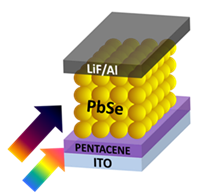DEMET ASİL ALPTEKİN
Demet Asil Alptekin is an Assistant Professor in the Department of Chemistry and leads the METU Quantum Dots Research Laboratory at Middle East Technical University. She got her BSc degrees on Chemistry and Chemical Engineering from Middle East Technical University. Later, she become research assistant at METU and studied on the electroluminescent polymers during her master studies. Later, she was awarded by Higher Education Council of Turkey and METU to conduct her PhD studies at University of Cambridge, Physics Department. She is also awarded by Schlumberger Company to become a Schlumberger Faculty for the Future Fellow.

Dr. Asil’s research focuses broadly on the design and synthesis of hybrid functional materials for the construction of high performance and low cost future electronics. She recently conducted a study with Sir Richard H. Friend from University of Cambridge on the surface passivation techniques for the PbSe nanocrystals. They found that the effect of controlling the surface states of PbSe is crucial for the photovoltaic performance of singlet fission sensitized hybrid solar cells.
In collaboration with Professor Jonathan Nitschke from University of Cambridge, Chemistry Department, she studied on the self-assembled supramolecular chemistry and they announced the first type of copper containing metallopolymer that can be applied to the light emitting diodes. The results also demonstrated that the heteroleptic metallo-polymers are capable of reconfiguring their structure and properties in response to stimuli, and they attributed these changes to the dynamic-covalent nature of the metal-ligand bonds. She is currently working on an interdisciplinary project funded by TÜBİTAK to develop surface passivation techniques for the lead based quantum dots and increase the photovoltaic efficiency of singlet fission sensitized solar cells.
 “Efforts are being made to design organic and inorganic hybrid structures that exhibit improved material functionality toward emissive materials, photovoltaic, sensing, data storage, nano-electronics and stimuli-responsive materials. Of particular interest are the synthetic polymers containing metal centers and nanocrystals as these materials offer a good strategy to construct low cost high performance optoelectronics and smart materials in the future.”
“Efforts are being made to design organic and inorganic hybrid structures that exhibit improved material functionality toward emissive materials, photovoltaic, sensing, data storage, nano-electronics and stimuli-responsive materials. Of particular interest are the synthetic polymers containing metal centers and nanocrystals as these materials offer a good strategy to construct low cost high performance optoelectronics and smart materials in the future.”
 “Efforts are being made to design organic and inorganic hybrid structures that exhibit improved material functionality toward emissive materials, photovoltaic, sensing, data storage, nano-electronics and stimuli-responsive materials. Of particular interest are the synthetic polymers containing metal centers and nanocrystals as these materials offer a good strategy to construct low cost high performance optoelectronics and smart materials in the future.”
“Efforts are being made to design organic and inorganic hybrid structures that exhibit improved material functionality toward emissive materials, photovoltaic, sensing, data storage, nano-electronics and stimuli-responsive materials. Of particular interest are the synthetic polymers containing metal centers and nanocrystals as these materials offer a good strategy to construct low cost high performance optoelectronics and smart materials in the future.”